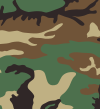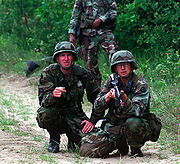
M81 Woodland
Encyclopedia

Military of the United States
The United States Armed Forces are the military forces of the United States. They consist of the Army, Navy, Marine Corps, Air Force, and Coast Guard.The United States has a strong tradition of civilian control of the military...
soldiers
United States Army
The United States Army is the main branch of the United States Armed Forces responsible for land-based military operations. It is the largest and oldest established branch of the U.S. military, and is one of seven U.S. uniformed services...
, Marines, airmen, and sailors from 1981, with the issue of the M81 Battle Dress Uniform until nearly the present day. It has been phased out by the Marine Corps for the digital MARPAT
MARPAT
MARPAT is a digital camouflage pattern in use with the United States Marine Corps, introduced with the Marine Corps Combat Utility Uniform , which replaced the Camouflage Utility Uniform. The pattern is formed by a number of small rectangular pixels of color...
with the introduction of the Marine Corps Combat Utility Uniform
Marine Corps Combat Utility Uniform
The Marine Corps Combat Utility Uniform is the current battledress uniform of the United States Marine Corps. It is also worn by Navy personnel assigned to Marine Corps units . Field testing began in 2001, the uniform debuted in 2002, and the changeover was completed in October 2004...
, the Army's digital Universal Camouflage Pattern
Universal Camouflage Pattern
The Universal Camouflage Pattern , also referred to as ACUPAT or Digital Camouflage is the military camouflage pattern currently in use in the United States Army's Army Combat Uniform. The pattern was chosen after several laboratory and field tests that occurred from 2003 to 2004...
with the introduction of the Army Combat Uniform
Army Combat Uniform
The Army Combat Uniform is the current combat uniform worn by the United States Army. It is the successor to the Battle Dress Uniform and Desert Camouflage Uniform worn during the 1980s and 1990s. It features a number of design changes, as well as a different camouflage pattern from its...
(ACU), The U.S. Navy maintains its use for specific units and organizations. The U.S. Navy SEALs and Seabees are the primary users of this uniform in addition to sailors wearing the trousers while working during flight deck operations aboard aircraft carriers. Sailors on ships and other navy catches have moved onto the Navy Working Uniform, and the Air Force's Airman Battle Uniform
Airman Battle Uniform
The Airman Battle Uniform is a service-distinctive camouflage battledress uniform for the United States Air Force. It is currently in full production and replaced the Battle Dress Uniform November 1st, 2011 after a four year phase-in period...
which uses a modern incarnation of the Tigerstripe
Tigerstripe
Tigerstripe is the name of a group of camouflage patterns developed for close-range use in dense jungle during jungle warfare by the South Vietnamese Armed Forces/US Forces. It derives its name from its resemblance to a tiger's stripes...
pattern. The camouflage pattern is still in use when it comes to NBC suits, and has also been seen on parkas' issued during basic training in the Army. Various law enforcement and SWAT teams also still use the woodland pattern for their personnel as well. Examples are LAPD SWAT, US DEA operators, Portland Oregon SERT team, Boise SWAT, and even the FBI HRT team.
Woodland pattern is identical to ERDL pattern
ERDL pattern
ERDL pattern is a camouflage pattern developed by the United States Army at its Engineer Research & Development Laboratories in 1948. It was not issued to elite reconnaissance and special operations units until early 1967, during the Vietnam War....
, but is printed from an enlargement of the original pattern. ERDL pattern was enlarged and the borders of the splotches were re-drawn making them less regular. Part of the earlier pattern was left off the later pattern because the enlargement made them no longer fit on the width of the pattern. The pattern does not repeat horizontally across the width of the bolt, but only vertically along the length of the bolt.
The effect of enlarging the pattern was to make the pattern more visible at a distance, avoiding "blobbing", where smaller areas of color seem to blend into larger blobs. This also made the pattern have a higher contrast
Contrast (vision)
Contrast is the difference in visual properties that makes an object distinguishable from other objects and the background. In visual perception of the real world, contrast is determined by the difference in the color and brightness of the object and other objects within the same field of view...
, and stand out more sharply at close distances. This defeated the camouflage effect of Woodland pattern at closer range. Digital and Flecktarn
Flecktarn
Flecktarn is a 3-, 4-, 5- or 6-colour disruptive camouflage pattern. The use of spots creates a "dithering" effect, which eliminates hard boundaries between the different colours in much the same way the squares in the newest digital camouflage patterns do...
camouflage patterns resolve this problem by using small blobs that converge into larger ones at longer range.
These changes reflected a shift in the tactical focus of the United States military from an extremely close-range war in Vietnam
Vietnam War
The Vietnam War was a Cold War-era military conflict that occurred in Vietnam, Laos, and Cambodia from 1 November 1955 to the fall of Saigon on 30 April 1975. This war followed the First Indochina War and was fought between North Vietnam, supported by its communist allies, and the government of...
to a longer-range battlespace on the fields of Europe.
See also

- Military camouflageMilitary camouflageMilitary camouflage is one of many means of deceiving an enemy. In practice, it is the application of colour and materials to battledress and military equipment to conceal them from visual observation. The French slang word camouflage came into common English usage during World War I when the...
- List of camouflage patterns
- United States Army Engineer Research and Development LaboratoryUnited States Army Engineer Research and Development LaboratoryThe United States Army Engineer Research and Development Laboratory was a United States Army Corps of Engineers research facility located at Fort Belvoir, Virginia. Among other things, it was responsible for the creation of the ERDL woodland camouflage pattern in 1948 and it established the first U.S...

